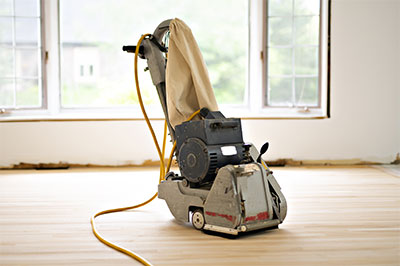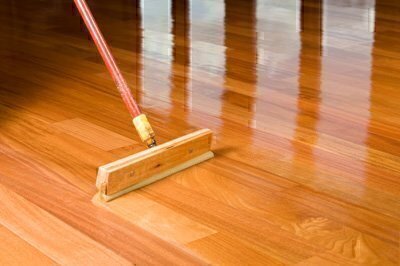Last updated August 2021
Want to renew your shabby wood floors? Here are your refinishing options and how to find the best help.
Wood floors last for generations, but kids, pets, furniture, and everyday dirt can spoil their appearance or cause damage, and sunlight can yellow or fade finishes. At some point you’ll need to refinish your floors. That’s when things get messy. And smelly. And inconvenient. And expensive.
 Refinishing School
Refinishing School
Many companies advertise “dustless” refinishing, but any sanding process produces dust. And most finishes are (to put it mildly) smelly. Most emit volatile organic compounds (VOCs) that linger for days and are (to put it really mildly) bad for your health and the environment.
Floors can be sanded a finite number of times. Sanding removes wood, and repeated sandings will expose the interlocking grooves between boards. Solid-wood floors are generally 3/4-inch thick when new and can be sanded three or more times. Engineered hardwood floors can also be sanded and refinished but typically just once. Engineered floors layer hardwood—typically 3/8-inch wood—on top of a manufactured plywood-like laminate. If you’re not sure what type of floor you have, remove the baseboard molding or check around floor grates.
The process of sanding and refinishing floors usually involves—
- Multiple sandings. Most jobs require three separate passes.
- Repairing defects. Refinishers will fill holes and gouges, and replace damaged planks that refinishing can’t salvage.
- Cleaning. Workers should minimize dust during sanding and then diligently vacuum and wipe everything afterward.
- Applying stain or a sealer. To help you choose a stain color, the refinisher can stain small areas with sample tints. If you prefer the wood’s natural color, the refinisher may apply a clear or nearly clear stain or sealant.
- Applying a surface finish. Refinishers usually use polyurethane, applying at least two coats and often three, buffing floors in between the first and second coats.
Types of Finishes
Surface finishes are the most common; they coat the surface of the floor and create a seal that protects the wood beneath. Surface finishes are usually polyurethane.
The various surface finishes have different qualities but work the same way: Once applied, they dry and harden on top of the wood. You might think of it as a clear coat—when you touch the floor you touch the finish, not the wood itself.
Penetrating finishes are much less common and substantially different from surface finishes. First, an oil is applied to bare wood, penetrating and sealing the surface. If the floors are to be stained, the stain is mixed into the oil base, and the floor is then waxed and buffed. The wax provides sheen and protection and must be reapplied periodically. When you touch a floor with a penetrating finish, it will feel like you’re touching the wood itself. It’s less protective than surface finishes but looks and feels more like the natural wood. Unlike other finishes, wax is nontoxic and emits very low VOCs.
Spot Refinishing
If your floor has only small problem areas, a refinisher can do spot restorations. This saves you most of the cost and mess of a full sanding and refinishing job, but it’s difficult—and sometimes impossible—to match exactly the appearance of a refinished small area to the rest of the floor.
Recoating
If you have a surface finish, no bare wood is exposed, and your floors are in generally good shape, consider recoating. Recoating skips the sanding, takes less time, and can cost less than half the price of a full sanding and refinishing job.
During recoating the refinisher will “screen” your floor, using a buffing machine with a fine-meshed screen—not sandpaper—to abrade the old finish. The abrasion allows fresh coats of surface finish to adhere.
Selecting Water vs. Oil
Durable and easy to maintain, polyurethane surface finishes are the most popular and most practical. There are various oil- and water-based products; each type has pros and cons. Some refinishers are loyal to one type or the other, as well as to particular brands.
Water-based polyurethane products offer several advantages. They dry in as little as two hours, allowing refinishers to apply multiple coats in a single day, which means workers can complete the job more quickly. They emit fewer VOCs, so they smell less, and the odor dissipates more quickly.
Water-based polyurethane appears clearer when applied (oil-based products may have a slight amber tint) and resists further yellowing better than oil. Some consumers don’t like the amber coloration; others find it gives floors a sense of warmth.
One advantage of oil-based products is that they are easier to apply in a smooth, consistent finish, without applicator marks. And because oil-based products contain more solids, the job usually can be performed with fewer coats than with water-based products.
Since both oil-based and water-based finishes can produce good results, your refinisher’s preference may determine your decision.
If you are concerned about VOCs and need to have your floors sanded down to bare wood, penetrating finishes are another option. But be aware that wax is less protective than polyurethane and requires annual maintenance (cleaning, buffing, and re-waxing).
Some soy-based polyurethane products and other alternatives virtually eliminate VOCs. But refinishers tend to be leery of them; several told us they’re difficult to work with.
 Choosing a Refinishing Service
Choosing a Refinishing Service
Start by review the ratings and reviews we’ve collected from area consumers. You’ll see that, in addition to living through the messy, smelly refinishing process, many homeowners endure lousy service. Roughly one in five customer reviews is negative, a lower satisfaction rate than most other types of home improvement services. Even more alarming: Most complaints relate to sloppy work, sometimes so sloppy that floors were ruined.
Ask three to five companies to price your job; if you provide info on the type of flooring you have, its general condition, the square footage, and type of stain and finish you want, most will provide proposals via email.
Our undercover shoppers obtained quotes from a sample of area refinishers for sanding and refinishing two rooms totaling 560 square feet (see table, below). Companies were asked to quote their prices for applying oil-based and water-based polyurethane finishes. We found enormous company-to-company price differences—for example, from $1,200 to $3,920 for a water-based finish.
Avoiding Problems
Before work begins, get a written fixed-price contract that includes all agreed-to terms: type of finish, number of coats, stain (if any) to be used, how moldings will be treated, dust protection systems to be used, schedule, payment, and guarantee. Points to cover:
- Ask about stained or damaged areas. Some stains (pet-related ones are notorious) are impossible to remove without replacing planks. Ask for recommendations and prices to deal with them. You may decide you can live with imperfections.
- Ask about baseboard/quarter-round moldings. Some refinishers sand up to the moldings and leave them, rather than remove them. Because this can scratch and mark the molding and leave a small visible edge of unsanded flooring below the molding, ask that moldings be removed and replaced.
- Ask about stain selection, especially if you want it to match another area. The company you hire can apply stain samples for your approval.
- Ask what finish the company recommends, and how many coats will be applied. Many companies prefer one method over another. For polyurethane, discuss and specify whether you want gloss, semi-gloss, or a satin finish. Gloss is the shiniest but shows scratches and other nicks more than the others.
- Ask how workers handle dust and cleanup. Some companies brag about “dustless systems,” but there’s no such thing. The key is diligence about cleaning during and after sanding.
- Discuss preparation. Some companies will take up carpeting or move furniture; ask who will do what.
- Make sure workers will cover HVAC vents and seal off work areas from other parts of your home.
- Ask for a schedule, so you’ll know when rooms are off-limits.
- Ask for a guarantee. At a minimum, request a year on workmanship and finish, against defects like cracking, peeling, bubbling, and clouding.
- Ask about payment terms. Avoid paying anything more than a small deposit until work is complete and you’re happy with the results.
- Ask about insurance. Ask the company to provide proof of workers’ compensation and general liability insurance. If it employs subcontractors, get proof of insurance for them, too.
If you are refinishing only one or two rooms, you can probably live with the inconvenience. But if the work takes place in a large common area, or includes a stairway, get outta there. And you might not be comfortable returning for several days depending on the type of finish. Once the first coat is applied, your family and pets won’t be able to walk across the floor until the last coat has dried. Also, the heating and cooling system will be turned off during sanding to avoid circulating dust.
When the finish has dried, inspect the entire area. Look for imperfections like bubbling or an orange-peel effect. Bring any problems to the company’s attention immediately.


